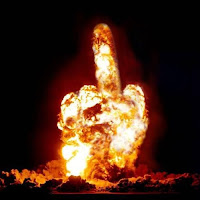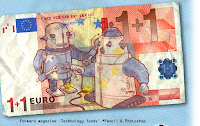National Library of Australia, Canberra, 3 December 2005 - 12 February 2006
Review by Michael McKernan
Ned Kelly (1855-1880), helmet, MS 13361, State Library of Victoria. Courtesy National Library of Australia
Courtesy National Library of Australia
It
is a story I have used many times, particularly when speaking to groups
of visitors to Australia. I was on a train in the United Kingdom and
had got into conversation with a fellow traveller, as you do. He had
asked what brought me to Britain; I had said that I was a historian,
working in a couple of libraries. Wonderful, he had said, a historian;
what is your field? Australian history, I had replied. Oh, he had asked,
is there any? It was a story that I could not get out of my head as I
made my first visit to the National Library to see the exhibition,National Treasures. This is our stuff, I kept saying to myself, our story, so let's not look down our noses at it.
And I remembered Edmund Campion's account of his visit to the National Library for Treasures from the World's Great Libraries in his thoughtful and meditative book Lines of My Life.
Campion had come to Canberra from Sydney the day before especially for
the exhibition, had woken very early and was at the Library and in the
queue by 4.15am. He was admitted to the exhibition just before 7.00am
and he thought that he might just spend all day there; he was
enthralled. 'The actuality of
everything in the exhibition space,' Campion wrote, 'was an important
element; reproductions or photographs would merely have given you the
information but would not have had the same impact on you. They would
not have connected you to the real experience. By contrast, everyone who
went to the Canberra exhibition came away with a heightened sense of
the values we call civilised. The experience had transformed them.'
There is no great queue snaking its way among the pillars in Canberra for National Treasures.
But why should there be, for this exhibition will travel to all states
and territories, opening in Melbourne at the recently and grandly
refurbished State Library in early March 2006 and to the other libraries
in their turn. Still, on the days I have looked at National Treasures in
Canberra, three days so far, the crowds have been steady and strong
and, like Ed Campion for the earlier exhibition, deeply engaged.
The
exhibition displays over two hundred items, drawn from the collections
of the National Library and all the state and territory libraries. The
National Library has contributed the highest percentage of objects,
about a quarter of the total, followed by the state libraries of South
Australia, New South Wales and Victoria. The exact proportions from the
various institutions will vary from one venue to the next, to take
account of conservation and other requirements.
James
Cook (1728-1779), Journal of the HMS Endeavour, 1768-1771. Manuscript
Collection, MS 1, National Library of Australia. Courtesy National
Library of Australia
Courtesy National Library of Australia
Of course the foundation documents are there. The Endeavourjournal,
Matthew Flinders' map, the first images of white settlement, evidence
of the surprise in Australian fauna and flora. Yet the big items do not
dominate this exhibition. It's whimsical, a friend said as she came out
of National Treasures,
and I think she had it precisely right. If these are the documents and
pieces that tell our national story, and in large measure they are, then
perhaps as a people we are whimsical and that is our story. Odd,
fantastical, delicately fanciful, expressing gently humorous tolerance.
There is much that is odd in National Treasures.
Fatso, the fat-arsed wombat, for example, one of the most loved
elements of the wholly marvellous Sydney Olympics. Precisely right in National Treasures for
that bit of our national story. We loved the Olympics, all of Australia
embraced the Games, to be in Sydney in those days was very heaven, but
we loved, too, Roy and HG with their nightly debunking on the Olympics
broadcaster, Channel Seven. Silly Syd, Millie and Olly, a playtpus, an
echidna and a kookaburra, were the official mascots of the Games ('to
embody Sydney and the spirit of the Games') but they weren't in the same
league as Fatso, who ends up in National Treasures; because Fatso had that element of self-mockery, self-deprecation, that is part of the Australian way.
Or
the extraordinary silver and wood model of the Snowy Mountains scheme
presented to the Governor-General, Sir William McKell, in thanks for his
attendance in the mountains to inaugurate the scheme. This sets the
mind wondering: why go to all the trouble? McKell, after all, was on
official duty. What happens to other gifts to governors-general handed
out to them for just doing their jobs? Are they all as elaborate as that
today?
Then there is the evidence of whimsical library practice thatNational Treasures also
discloses to the really discerning visitor. Look at the convict
leg-irons in the 'Settlement, Land and Nature' section of the
exhibition. Brutal, solid, fearsome. You wouldn't get too far locked
into those things. Again the mind races: our inhumanity, the terror of
our first beginnings; Port Arthur, a place of national shame. But look
at the caption. Tasmanian c. 1840. State Library of Victoria. Pictures Collection. Pardon?
I'm
reminded that libraries collect much more than works on paper. Nearly a
fifth of the objects on display in Canberra are classified as
(three-dimensional) objects. Manuscripts and printed material make up
more than half the total, followed by paintings, prints and drawings,
and photographs. Then come maps, sketchbooks and diaries, and oral
history recordings.
In
contrast to the convict jacket, the exhibition provides evidence of the
civilisation and civility that came to Australia in the earliest days,
and the skills that people brought with them. Was every military officer
an accomplished artist? There is exquisite evidence to suggest that it
might be so. Was every one of them an engaging diarist and observer?
Again the evidence would lead you to think so. This is not drawn out for
you in the text panels: rather, the beauty and significance of these
works emerge in an understated way that is characteristic of the
exhibition.
Mary Watson, diary fragment, 8 September 1881, State Library of Queensland. Courtesy National Library of Australia
Courtesy National Library of Australia
Some
of the diaries make remarkable reading and it is the serendipitous
nature of their presence here that sparks the imagination. I noticed
that people really wanted to read what the diarists had set out for
them, and made good use of the well-placed hand rails, just below the
bottom of the glass of the exhibition cases: a design feature that other
exhibitions would do well to emulate. For a game, go from one diary to
the next, ignoring all that is not personally written and intimate to
the writer. What variety of experience, narrative skill, and life
experience you will discover. What sadness, too: Mary Watson's diary
fragments detailing the last days of her life, and of her four-month-old
son and Chinese servant, dying of thirst in a makeshift boat. Make
sure, too, that you do not miss Shane Gould's diary, as touching an
object in the exhibition as any.
Perhaps
for me there was an element of predictability in some of the items on
display. Am I the only Australian little moved by Ned Kelly's armour? Or
Don Bradman's bat? (Though I was taken with his 1946-47 blazer: what a
small man he must have been, or how tightly the blazer might have
fitted.) I suppose the 'iconic' items draw the people in and the
unexpected items arouse and astonish them.
But
this is not really an exhibition for hardened old historians such as I.
We have been lucky enough to have lived with this type of stuff all of
our working lives. That it can still excite and stimulate us is tribute
to the richness of the material on display. But the point of this
exhibition is to open to those who would never normally make it to the
manuscript reading room something of the joy and excitement to be found
there. You could imagine someone deciding to become a historian of
Australia, simply as a result of a visit to National Treasures. It could be, as Ed Campion found earlier, a transformative experience.
The
exhibition's design allowed clear viewing of the displays. Two of Eddie
Mabo's daughters, Jessie Mabo (left) and Maleta West view some of their
father's papers. Courtesy National Library of Australia
Courtesy National Library of Australia
A
cabinet of curiosities, that's what we need, one of the directors of
the Australian War Memorial used to say. Let's stop directing people in
the way we want to tell them the story; let them start discovering
things for themselves. A cabinet of curiosities as our National Treasures?
Randomly selected items to give the taste and flavour of the Australian
story? I suppose those who worked so hard for this exhibition and met
over so many long hours endlessly debating including this against that
would give a wry smile at the idea thatNational Treasures has the feel of a cabinet of curiosities. But it does.
And
it so suits the whimsicality of our story. Little bits and pieces, a
surprise at every turn, telling us who we are and where we have come
from. Material to study earnestly, to examine carefully, to laugh over
with a friend, to reflect on privately; but none of it to pass over
lightly. For this is an exhibition that tells us that we do indeed have a
history; but our history is not like the history of other folk. And
possibly only we can truly understand it. For, despite the best
endeavours of those who do not understand us as a people (our
politicians among them), we are not like all the peoples elsewhere. We
are our own folk; telling us that is the achievement of this exhibition.
National treasures, indeed.
Michael McKernan is a former academic and museum administrator. Now a writer and broadcaster, his most recent book is The Brumbies: the Super 12 Years.

































































